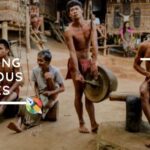This post is the precise notes of NCERT class 9th history chapter 5 Notes by Vibha Maam.
Pastoralists in the Modern World
Pastoral Nomads and their movements
Nomadic people move from one area to another with their cattles in search of pasture and living in the mountains.
Gujjar Bakarwal
The tribe of Jammu and Kashmir are herders of goat and sheep. They move annually between summer and winter. In winter they lived with their herds in the low hills of Shivalik range. In summer by the end of April they began to move Northern where a variety of grasses sprouted for the herds. By the end of September they move again in the low hills. This cycle continues year by year.
Gaddi Shepherds of Himachal Pradesh
They also had a similar cycle of seasonal movement. In winter they came down in low hills of Shivalik range with their flocks. By April they moved north and spent summer in Lahul and Spiti. when snow melted on the mountain they moved on to the higher meadows. By September they begin their return movement once again. They stopped in Lahul and Spiti, reaping their summer harvest and sowing their winter crop. Then they descended Shivalik hills. By April they returned to the mountains.
The Gujjar tribe of Garhwal and Kumaon
The Gujjar cattle herders came down to the bhabar in winter and went up to the high meadows in summer. Bhutiya, Sherpas and Kinnauris are the pastoral communities of the Himalayas. The seasonal movement between summer and winter pasture was typical for nomads of Himalayas.
On the Plateau Plains and Deserts
Plateau
Pastoralists were also found in plateaus, plains and deserts of India. Dhangars (Maharashtra) were shepherds and buffalo hardeers. They stayed in the Central plateau of Maharashtra during monsoon. This was a semi-arid region. Only dry crops like bajra could be sown here. By October they harvested their bajra and moved toward the west and reached the Konkan. Konkani peasants welcome the shepherds. Dhangar flocks manured the fields and fed on the stubble. With the onset of the monsoon the Dhangar left the konkan (coastal area) and returned to the dry plateau with their flocks.
Plains
The Gollas
In Karnataka and Andhra Pradesh the Gollas herded cattle. The kurumas and kurubas reared sheep and goats, sold woven blankets, and cultivated small patches of land in woods. Their movement depended on the alternation of the monsoon. In the dry season they moved to the coastal tracts and left in the rain.
Desert
Banjaras were found in the villages of UP Punjab, Rajasthan, Madhya Pradesh and Maharashtra. They moved over long distances in search of pastureland selling cattle and other goods to villages in exchange for grains and fodder.
The Raikas lived in the deserts of Rajasthan. They reared sheep and goats. They combine cultivation with pastoralism. the Raikas of Barmer, Jaisalmer, Jodhpur and Bikaner, during monsoon they stayed in their home villages and by october they moved out in search of pasture and water. They returned to their home again during the next monsoon. Maru (desert) Raikas herded camels.
Colonial rule and pastoral life
Under colonial rule, the life of a pastoralist changed dramatically.
-
- Wasteland rules:- by these rules uncultivated land was taken over and given to villages’ headmen to expand the cultivation.so expansion of cultivation inevitably meant the decline of pasture and problem for pastoralists.
-
- Forest Acts:- through these acts some forests of sal and deodar trees declared reserved and other forests were classified as protected. No pastoralist was allowed access to these forests but some customary grazing rights were granted in protected forests. their movement was regulated. they needed a permit for entry and it was specified and limited.
- Criminal Tribes Act:- in 1871, the colonial government passed the criminal tribes act. By this act many communities of craftsmen, traders and pastoralists were classified as criminal tribes.they were fixed at a particular place. they were not allowed to move out without a permit. The village police kept an eye on them continuously.
- Taxation:- to expand their revenue income, the colonial government imposed taxes on land, on Salt, on canal water,on trade goods and even on animals. Grazing tax was introduced in the 19th century. By 1880, the government began collecting tax directly from the pastoralists.
How did these changes affect the lives of pastoralist
Taking over the grazing land and the reservation of forest means the serious shortage of pastures. This created further shortage of forage for animals and the deterioration of animal stock, underfed cattle died in large numbers during scarcities and famines.
How did the pastoralist cope with these changes
- Some reduced the number of cattles in the herds.
- Another discovered New pasture.
- In recent years Raikas have been migrated to Haryana where sheep can graze on agricultural fields after the harvests are cut.
- Over the years, some rich pastoralists began buying land and settling down.
- Some became settled peasants, others engaged in trading.
- Whereas many poor pastoralists borrowed money from the moneylender, working on fields and in small towns.
Pastoralism in Africa
The world’s half pastoral population lives in Africa. They include communities like Bedouins, Berbers, Maasai, Somali, Turkana and Boran. Most of them live in the semi grasslands. They rear cattle, camels, goats, sheep and donkeys. They sell milk, meat, animal skin and wool. They combine pastoral activity with agriculture and trade.
The Masai: A Pastoral Community
Maasai land stretched over a vast area from North Kenya to Northern Tanzania before colonial times.
One of the major problems is continuous loss of grazing lands. In 1885, Maasailand was cut into half with an international boundary between British Kenya and German Tanganyika. From the late 19th century, the British government encouraged local peasant communities to expand cultivation. as cultivation expanded pastureland were reduced
Large areas of grazing land were also turned into game reserves like the Masai mara and Samburu National Park in Kenya and Serengeti Park in Tanzania. pastoralists were not allowed to enter these reserves. feeding the cattle has become a persistent problem.
The Border are closed
From the 19th century the British government began imposing various restrictions on their mobility. Like the Maasai, other pastoral groups were also forced to live within the confines of special reserves where they were not allowed to move out with their stock without special permit. Pastoralists were also not allowed to enter the market in white areas. in many regions, they were prohibited from participating in any form of trade.
The new territorial boundaries and restrictions adversely affected both the pastoral and trading activities. When rains fail and pastures dry, drought affects the life of pastoralists everywhere. Nomadism allows them to move from one place to another to survive bad times and avoid crises.
But from the colonial period the Maasai were bound down to a fixed area. They could not shift their cattles to another area for pasture. large numbers of Masai cattle die from starvation and disease in these years of drought. In just two years of drought, 1933 and 1934, over half the cattle in the Maasai Reserve died.
Not All were equally affected
In pre-colonial times masai society was divided into two social categories- elders and warriors. The elders formed the ruling group and settled community affairs and disputes. The warrior consisted of the younger people mainly responsible for the protection of the tribe.
But in the colonial period, the British appointed chiefs of different sub-groups of Maasai to administer the affairs of masai. The British imposed various restrictions on raiding and warfare. Consequently, the traditional authority of both elders and warriors were adversely affected. The chief appointed by the British had a regular income. Many of them began living in towns and involved in trade.
But the life of poor Pastoralists who depended only on their livestock was different. Their life was nearly devastated in times of war and drought. they lost almost everything. they had to go searching for work in the town
Conclusion
These pastoral groups were sustained by a careful consideration of a host of factors. They had to set up a relationship with farmers on the way so that the herds could graze in harvested fields and menured the soil. They combined a range of different activities like cultivation, trade and herding for their living. Many ecologists and environmentalists believe that in dry reason and in mountain pastoralism is still ecologically the most viable form of life.
Share this note with your friends and classmates and also comment in the comment section below.
For Novels and books at affordable price you can checkout Checkfirst
Stay tuned for more amazing post & articles like this.






